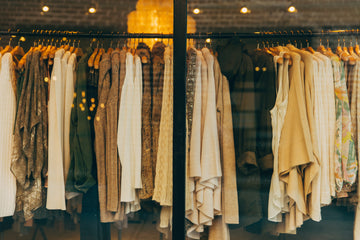Does it make anyone else’s head spin to see coats and thick sweaters on store shelves in July? Yeah, us too. Fast fashion operates on a system of 52 micro-seasons per year, which launches us, as consumers and as retailers, into a cycle of endless consumption and waste. The idea of 52 micro-seasons may sound impossible at first (I mean, who needs 52 micro-seasons worth of clothing per year?) but, odds are, you’re probably very familiar with the big brands who proliferate this kind of fashion production. Think about any large retailer that sells affordable clothing in mass quantities - to keep up with consumer demand and the mass “throwaway” culture that we have created, there is little to no room for big brands in this cycle to slow down. The worst part is over 85% of all textiles go into landfills every year, but we’re consuming double the clothing that we were in 2000.

Despite these facts, there seems to be a growing divide in the fashion industry between fast fashion and slow fashion. A report by Harper's Bazaar has indicated that the days of “pre-spring” and “pre-fall” launches are coming to an end for some retailers, as we have “seen designers move away from trends in favour of putting timeless pieces on the catwalk.” The idea of seasonality in fashion has been adapting for some, as major brands have been pairing boots with midi-dresses for summer or turtlenecks layered under t-shirts for fall. More and more, in response to the time-crunch for action on our growing climate-emergency, designers are rethinking the need to create beyond the earth’s limited resources.
By definition, seasonless fashion is fashion that does not subscribe to season-oriented trends. For example, we don’t think that you should be able to look at a garment and recognize that it is so Spring 2017. Seasonless fashion conjures up the idea of a certain timelessness - for example, the white t-shirt, denim and black pants. Seasonless doesn’t necessarily translate to “basic,” though - it simply means that your piece isn’t irrevocably tied to a particular trend or season.

At DAUB, we don’t subscribe to the idea that garments are only made to live for one season. Each of our pieces is designed to take you through the whole year and your whole day, and we carefully and critically examine how our prints translate from winter to summer. What’s more is that our clothes are made in a small-batch production method, which by definition means that a manufacturer make less than 500 units in any particular production run. We actually usually make around 80-150 units per style across our size range. As such, we usually have very limited inventory on hand, and, as a small business, we approach this as being part of our strategy and our sustainability initiatives. It’s very possible to handle selling limited stock, and we do it in a couple of different ways - first, we run pre-sales. If you’ve ever participated in one, you’d know that as a part of a pre-sale, we only create what you order in your size so that we are only creating what will be worn by our customers.

Another tactic that allows us to continue with small-batch production is avoiding over-launching. You may have noticed that we don't often launch new products, and if we do, we don’t consistently launch seasonal items. When we see gaps between what we offer our customers and what they want, we adapt, but DAUB is made to be a part of your minimalist wardrobe and so we create like that, too. We’re after the same dream that you are - we want you to look at your wardrobe and say, "I know exactly what to wear."
